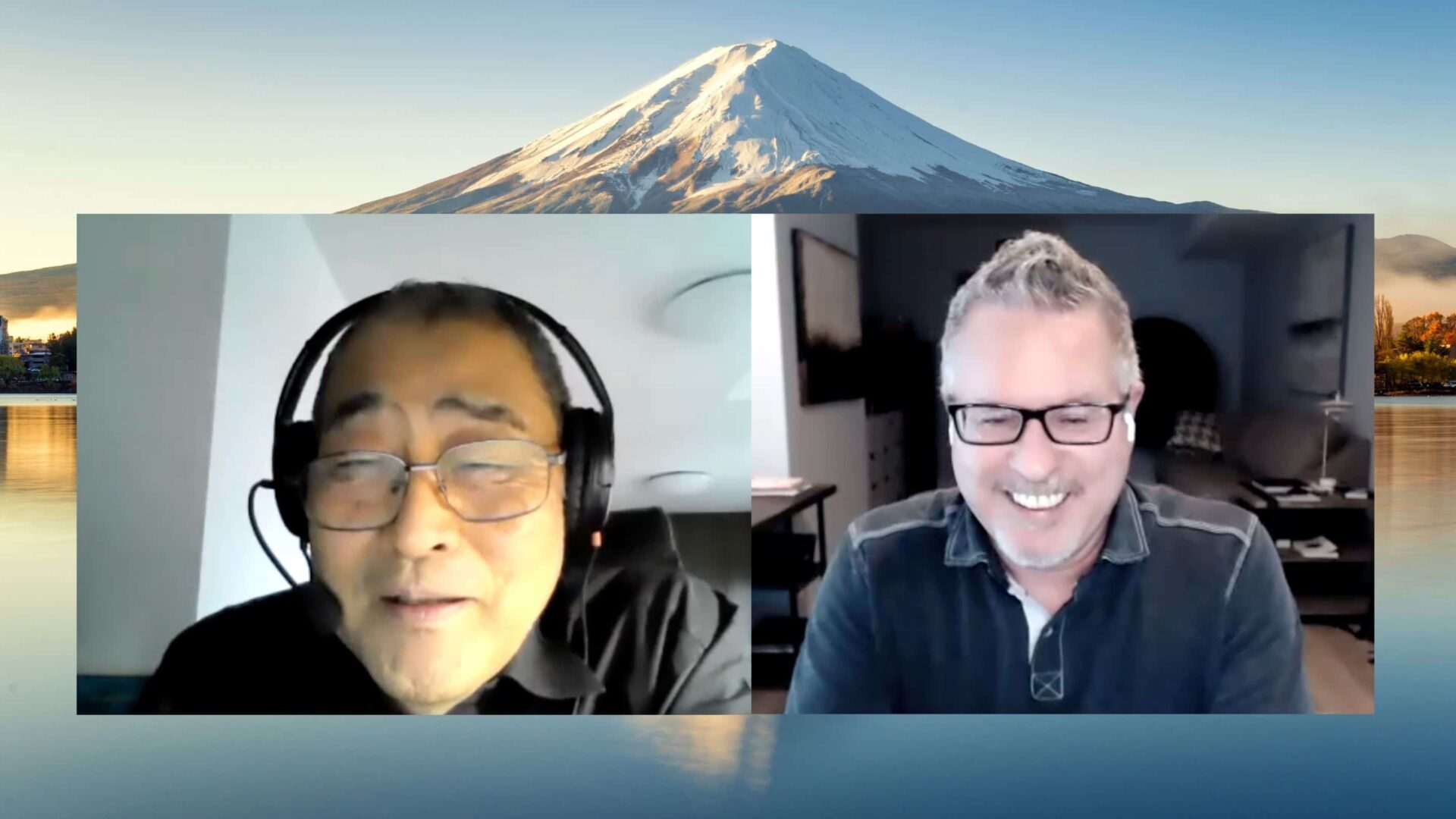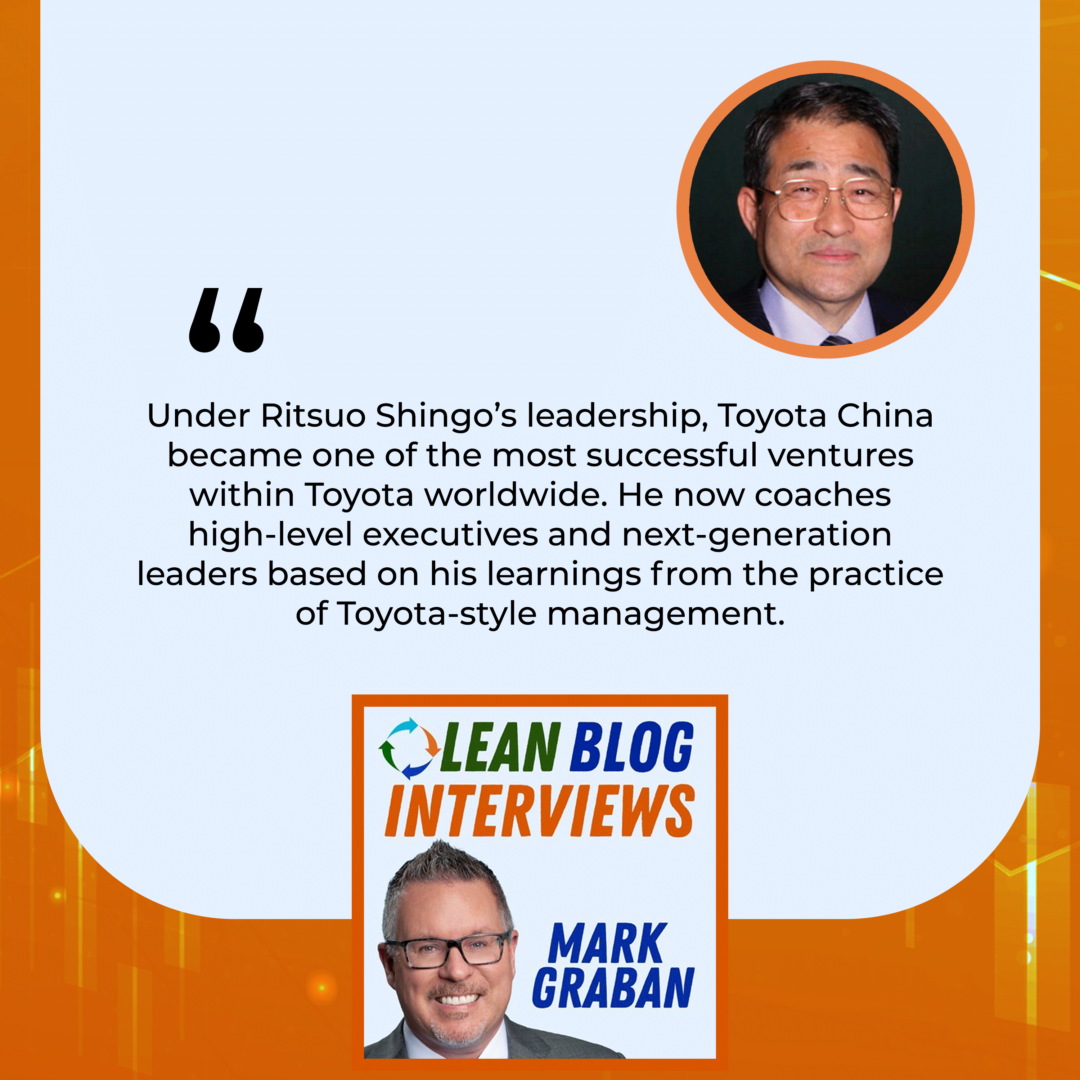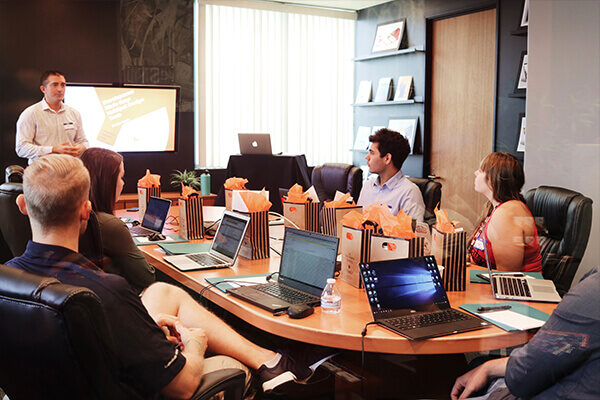
My guest for Episode #409 of the Lean Blog Interviews podcast is Ritsuo Shingo. I first met Mr. Shingo at the Shingo Institute Annual Conference in 2009 when my book Lean Hospitals received the publication prize that's named after his father, Shigeo Shingo. I was also blessed to have time to speak 1×1 with Mr. Shingo, thanks to our mutual friend, the late Norman Bodek, which included discussions about the need for mistake proofing in healthcare — very vivid memories for me.
Ritsuo Shingo is an expert in leadership with more than 40 years of experience serving at top management positions at Toyota. He was the founder and the first president of Toyota China. Under his leadership, Toyota China became one of the most successful ventures of Toyota worldwide. Following this success, he was appointed as the president of Hino Motors and then served as the president of GAC-Hino until 2009.
Shingo was the translator of the first book on Toyota Production System in English written by his father, TPS pioneer Shigeo Shingo, in 1976. He applied his father's and other TPS pioneers' teachings into his management practices.
Today he dedicates his time to coaching high-level executives as well as teaching the next generation of leaders his learnings from the practice of Toyota-style management.
Topics and questions in today's episode include:
- What was the most important thing you learn from your father?
- What do you remember about translating the green book?
- Big misunderstanding… in the West, they thought suppliers should keep big inventory even though Toyota had none
- Just in time requires local suppliers, frequent deliveries, and high quality
- You need close relationships with suppliers, win/win collaboration
- How do you explain TPS?
- “An accumulation of small improvements”
- “Wherever you go, workers are not the problem”
- “It's a management problem, but sometimes they blame workers”
- He told a plant manager he was “escaping from his responsibility”
- What is the origin of the term SMED – Single Minute Exchange of Die?
- What are the golf origins?
- Should it have been called SDED – Single Digit Exchange of Die, since it means “single digit minutes” not “one minute”?
- “It's too late”
- You define TPS as “organisational fitness to adapt” rather than a set of methodologies — what do you mean by that? Please tell us more…
- “Nobody ever told me what Toyota culture was” — the culture is the people
- Is a fully automated plant the best plant? No
- How has Toyota fared so well during the pandemic?
- Helping the supplier reduce costs together, versus just demanding a lower price (Nissan, Tesla, etc.)
- Favorite memories of our friend Norman Bodek?
- Tell us more about the workshop
The podcast is sponsored by Stiles Associates, now in their 30th year of business. They are the go-to Lean recruiting firm serving the manufacturing, private equity and healthcare industries. Learn more.
This podcast is part of the #LeanCommunicators network.
Listen to the podcast here
Ritsuo Shingo On The Toyota Production System And SMED

I'm honored that our guest on the show is Ritsuo Shingo. He is a familiar name to our audience. He is a leadership expert. He has more than 40 years of experience working at Toyota, serving in top management positions. He has been working since he retired from Toyota to help other leaders in other organizations. He was the Founder and the first President of Toyota China.
Under his leadership, Toyota China became one of the most successful ventures within Toyota worldwide. Following this success, he was appointed as the President of Hino Motors and served as the president of GAC-Hino until 2009. He was the translator of the first book on the Toyota Production System in English which was written by his father, TPS pioneer Shigeo Shingo in 1976.
He applied his father's and other pioneers' teachings to his management practices. Now, Mr. Shingo dedicates his time to coaching high-level executives, as well as teaching the next generation of leaders his learnings from the practice of Toyota-style management. He is teaching a virtual class on leadership starting on April 15th. I will invite everybody to learn more about that workshop. Mr. Shingo, thank you so much. It is an honor to have you here as a guest. How are you?
You are most welcome. I'm pleased. It is my pleasure to be here.
It is an honor to speak to you. I saw you give remarks at Shingo Conference ten years ago. I'm excited that we can hear some of your thoughts and I can share it with the audience. Thinking back to what you learned from your father even at a young age, what were some of the most important lessons you learned from your father, Shigeo Shingo?
One big thing I have learned from him is from his book. He is always working. I have never seen him doing something else other than working. He was on a train in Shinkansen, and he was writing a book. When he was home, he was recording for the lecture. He was always working. He was enthusiastic and does a good job. That attitude is something I have learned from him.
Beyond how hard he worked, what do you think are the most important lessons that were written in the famed green book that you translated? What do you think is the most important thing that somebody reading it now should understand from that book?
It was quite a long time ago. It is difficult to remember. That book was his basic understanding of TPS. He appreciates TPS. He wrote that Kanban is not a concept. It is a tool. He mentioned, “Kanban is nonsense.” He didn't mean it was meaningless. The Kanban is important, but he tried to let the people understand the much deeper concept rather than the tool. That is why he mentioned that the Kanban is just a tool. He tried to give a strong message about the concept of production.
His biggest contribution was SMED or Single-Minute Exchange of Die. The naming is me, but the content is his. Once he learned the concept of his thinking, many people were successful in reducing the inventory volume and the lead time. That made a big contribution. If you learn the concept, then the application is yours. He didn't know what you were doing at Gemba. I'm the same. I don't know any Gemba of yours. Once you have learned the concept, you can apply the concept to your Gemba. It is important that you understand the concept, then the application is yours. That is my thinking.
When you talk about the deeper concepts, is it important to think of how Kanban fits into the broader Toyota production system? What do you mean by the deeper concepts?
When I talk about the concept, it is basic thinking. Elimination of waste is a big issue. Toyota was always doing reduction of costs, elimination of waste, continuous improvement, and problem-solving. The Kanban was working to reduce the inventory because of the timing. Just-in-time was a basic concept of TPS, but the Kanban is the tool to realize that just-in-time. Just-in-time is the only necessary product, volume, and timing. That means you don't need to supply to Toyota. Toyota requests only products, volume, and timing. Both Toyota and the supplier can reduce inventory.
The supplier doesn't carry any inventory. There was a big misunderstanding in the Western world that Toyota was enjoying just-in-time, but not the suppliers. They should keep a huge inventory to enable just-in-time. Actually, they don't. Why? Because as soon as they produce, they can ship to Toyota. That is frequent delivery. They don't need to keep inventory. Whenever Toyota requests to produce, that means Toyota is sure to receive. The suppliers don't need to keep any huge or excessive inventory.
When I was asked, “What is TPS? How do you explain TPS to a person who doesn't know it at all?” I was asked by Paul Akers. He is a famous person. He gave me a difficult question, “How do you explain?” I said, “It is a tough question. My understanding is it is an accumulation of small improvements. It is a lot of improvements.” Toyota made a lot of improvements. Still, that improvement is going on. When I joined Toyota Motor in 1970, it was not the plant that it is now. It is a big difference. Why? Because Toyota has been changing. It is flexible and changing with continuous improvement. Many factors are there to be successful for Toyota.

You mentioned the idea that just-in-time requires frequent delivery. When I lived in San Antonio, Toyota built a factory in San Antonio. They have many suppliers directly around the factory or connected to the factory because Texas did not have local suppliers. To me, that represents just-in-time. I would propose another common misunderstanding in the West. Newspaper writers blame just-in-time when a boat gets stuck sideways in the Suez Canal. They say, “See, just-in-time doesn't work.” If there is a slow boat going through the Suez Canal, that is not frequent deliveries. That's not just-in-time. It seems incorrect to blame just-in-time. If the companies were doing just-in-time, they wouldn't have to worry about a boat getting stuck in the Canal. What do you think?
To enable something like just-in-time, you need to do many things. Even if you supply just-in-time, like Toyota, if there is no quality, what would happen? There's no meaning. Many things support to enable the concept. The Canal problem is the same. It is a delivery shipment. If there is an accident, then it doesn't work. What we should do is always keep the flow of the products from supply. Everything should be kept and maintained. With the Canal problem, if we clean all rocks beforehand so that no problem happens, that is something we should do. The problem never happens. To make it happen, we need a lot of effort. We need to do a lot of things to make it happen. Without that, TPS doesn't work at all. Abnormal condition is difficult to let the TPS happen. How should we make it a normal condition? That is a lot of effort or preparation. Otherwise, it doesn't work.
When you started in China, did you and Toyota develop local suppliers?
Yes.
That seems to be an important element of just-in-time.
It is extremely difficult to develop local suppliers. Even in China, wherever we place the plant, we try to buy locally. Locally means as close as possible to the plant. Is it possible to buy from the local Chinese suppliers? It is almost impossible. It is very difficult. That happened in the United States, Europe, and Japan. We should always keep the suppliers better. To do that, we should have a close relationship. We should select suppliers who are cooperative. Otherwise, if they don't listen to us, we cannot help.
We try to send the people, have close communication, and establish a win-win situation. The quality level of the supplier is not high. In China, that is the case. It's not so high. In the end, the product's quality is not stable at all. We try to make the coaster not like the coaster in Japan, but it's so-so quality. So-so is okay. Why? The competitor's minibus is not so-so. Toyota's so-so quality is a little bit higher than other people's. We try to achieve better quality than competitors. We train the suppliers. We try to receive parts from suppliers that are so-so quality. We try to train the workers, which our competitor didn't do. We try to train our workforce and people. They have learned.
In 2020, we tried to do our best effort. I came to the conclusion that there is no worker's problem wherever you go. In China, we made it. The workforce did a good job. Whether you are in Mexico, the US, China, Vietnam, or wherever you go, there is no workforce or worker problem. If there is a problem, it is the management problem. The management people said, “Blame the people.”
There is no workforce or worker problem. If there is a problem, it's a management problem. Share on XThe plant manager blames people, “They are not good. They don't listen. Even if they have learned, they forget. They are poor and no good workers.” I told that plant manager, “You sound like you are escaping your responsibility. It is your responsibility to educate, train the people, communicate with them, pull out their talent, and develop their abilities so that they can make a contribution to any activity.
It is not simple, but it is like an orchestra harmony. Everybody should play their role and try to be better for the benefit of their company. That is the only way you can survive. Without the company's continuous or sustainable situation, we lose jobs. If the company fell down, what would happen? We lose our job. It is quite natural. Management and the workforce both make an effort to keep competitiveness. That is important.

One question I had going back to earlier. You said SMED was your father's concept, but the English words and the acronym SMED were your creation when you translated the book. Is that correct?
I didn't create that at all. I was wondering what the Single-Minutes Exchange of Die is. It is written in Japanese.
How do you say it in Japanese?
Dandori means the change of tool. I asked my father, “Why you called it single?” In Japanese it is shinguru dandori. He explained to me how he learned to play golf after he was 60 years old. He learned that for an amateur player, a single handicap is great. It's less than ten. He likes it. He was like, “Let's take that name to the quick change.” Physically it doesn't mean within ten seconds. What he meant was to make a quicker change of die. To show quickness, he liked to use single handicap.
After listening to his explanation, we make it and I translate it, Single-Minute Exchange of Die. That is SMED. I proposed Single-Minute Exchange of Die, and he agreed. That is how we try to use SMED. Some American people told me, “It is not good English as a grammar. It should be single-digit something.” I answered, “It is too late already. I translate it as Single-Minute Exchange of Die.” They were like, “Single-Digit, can we say SDED?” I was like, “No.”
Ken Snyder, the director of the Shingo Institute, called me, “Shingo-san, there was something wrong.” I told him, “It's too late. Everybody in the world is using the term SMED. It is just a name.” At that time, when I translated SMED, I didn't know whether the people in the world use it or not. Even in China, they use the term SMED. They understand the meaning itself. They don't understand what to do. Wherever you go, Europe, the US, and Mexico, everybody understands SMED. I didn't translate it. I proposed and discussed it with my father. He agreed that this is SMED.
I was fortunate to have good teachers who taught me the idea of a single-minute, maybe 9 or 5 minutes. Often people, if they hear a single minute, they think of one minute. It doesn't strictly mean that. Maybe that is a misunderstanding.
The processing and concept are important. How to reduce the change-over time to become a quick change-over is important. As a result, sometime it could be 10 or 20 minutes. It is okay. From 3 or 4 hours to 10 minutes makes a big difference. At Toyota Motor, the change-over time of the stamping press mold used to be four hours.
Mr. Ohno requested the TPS people to reduce it to two hours. They couldn't do that. That is why they requested my father to do that and help them. He did it. Mr. T. Ohno was informed that they reduced it to two hours but in half. Mr. T. Ohno requested the TPS people, “Please reduce it to half an hour or twenty minutes.” They couldn't do that.
How come they couldn't reduce from 4 hours to 2 hours? How come they couldn't reduce 2 hours to half an hour or 20 minutes? They couldn't. My father was requested to help again. At that time, he told me that he wrote the concept of thinking or thought. It's like a flash into his brain. He wrote all the concepts. That is what we call the Single-Minute Exchange of Dies or SMED system. That is how he made it. That is SMED.
The one part of the story that was new to me from reading your book was the golf origins. I did not think of it like a golf handicap, but I do want to say congratulations. I'm sure the Japanese people are happy about Hideki Matsuyama winning the Masters.
I was watching. It is great.
One other question I like to ask you, Mr. Shingo. You talked about TPS, meaning an organizational fitness to adapt. That is an interesting concept. I was wondering if you could talk about that.
People are quite often talking about culture. Even Shingo Institute adds a culture factor to the center. In the past, there was no culture factor. Culture became important, thus the Shingo Institute set the culture factor in the center. I realized culture. There was a book written about Toyota culture. Unfortunately, nobody told me what Toyota's culture is. I was like, “Toyota culture, what was that?” I didn't learn what Toyota culture is. I was thinking, “What is Toyota culture?”
My thinking is it is related to people. Toyota Motor didn't have any Toyota culture. Toyota's people have a culture. All at once we change all people into newcomers. Where is the Toyota culture go? Where is Toyota's culture? It is gone. We should build once again Toyota culture. That is the people. How is the culture? Does a machine or a robot have a culture? No, it is the people.
Toyota Motor didn't have any Toyota culture. Toyota's people have a culture. Share on XMany TPS concept is related to people like visual control and visualization. Is that related to a machine? No, it is related to people. Visualize and people watch. The standardization is, is it for machines and robots? No, the showing standard means for people. Problem-solving, people. Continuous improvement, people. Many factors of TPS are related to people. Quite often, I'm asked, “All automation is done, and nobody is there. What happened? Is that the best plan?” I said, “No.”
Where is the happiness of the people? If everybody loses their job, is it a happy situation? No. Toyota tries to adapt to many people and try to improve them. The people are key. What we say is Monozukuri is the manufacturing of something. Hitozukuri means building people. Building products means building people. That is the concept of Toyota's thinking. Total participation is people. Without people, nothing happens. Sustainability is related to people. Most of the concept we are doing is for the people. People are key.
When you said the organizational ability to adapt, that is the people's ability to adapt.
When I talk about people, how are they motivated? That is important. Motivation did not come from the order or the request from the top management. It is not the order. Motivation comes from the ownership of the workers. When I was doing some training course in some company, I requested the plant people to join the meeting. They are not members of the trainee participants.
All managers and supervisors are the members, or the top management. They are pleased to be invited to the meeting and talk about the improvement activity. They are happy. They quite often told at the conference, “Nobody at this company did ask the workers to join the meeting and ask for their opinion. Nobody in the past. Now, they are happy to be here.”
At the same time, I request them to explain to everybody what they have discussed. I didn't ask the participant to explain. I asked each operator and worker to explain what they had discussed and what is the improvement activity. They are so pleased. I realized “Ownership is important.” To have ownership, they should join and participate in the activity. Otherwise, if they are doing only what they are told to do, there is no ownership and motivation. If they are invited to join the activity, there is ownership.
If there is ownership, there could be sustainability because they own, create, join, and participate in the activity for improvement. Once they set up certain standards or some improvement, then they can do it. If they didn't join, there would be no ownership. It is difficult to realize sustainability. That is my thinking. It is people.

When we talk about fitness and adaptation, in the past years with the pandemic, Toyota was the only automaker that made a profit during the pandemic. There have been semiconductor chip shortages that have affected other automakers except Toyota. They were least impacted by that. How is Toyota managing to be successful in these challenging pandemic times? What do you think?
I was surprised when I learned the information that only Toyota, among all good worldwide carmakers, became the company to be profitable. Why only Toyota? I was surprised. I was thinking, “That is maybe because we are doing the essential thing or the concept.” That is the only reason. We are always doing improvement activities, elimination of waste, and cost reduction. Without cost reduction, we cannot survive. If you manage your company with a lot of waste, in this situation, you cannot earn a profit. Toyota Motor always tries to be healthy. Healthy means trying to reduce the cost.

In the past, journalists misunderstood price cutting and cost reduction. Nissan Motors' top management used to be the other cost cutter. I thought, “Journalists didn't understand. It is not cost-cutting. What they were doing was price cutting.” When he tried to level up the Nissan Motor situation, he said, “Someone who gave them the lower price level, please raise your hand. You can continue to be a supplier. Those suppliers who are not able to reduce the price should go away.”
A lot of suppliers went away, but Toyota did not do that. It turned out we were always doing cost reduction, not the price-cutting. Cost reduction is done through the joint effort. Toyota tried to help the supplier be healthy. We have never taken up all profit from the improvement. Toyota helped and shared the profit. That is how we try to survive. It is a win-win situation. In this bad situation, suppliers and Toyota try to reduce costs. Without the reduction of cost, we could not survive or get any profit at all.
Toyota could get a profit because of cost-reduction activity with the big help of the suppliers. That is a win-win situation. Other companies, if they don't do that, they could not get any profit at all. That makes a difference. That was my understanding. Toyota was doing the original concept. We stick to the concept. Be healthy, reduction of costs, continuous improvement, and do what we have done in the past. We are doing it now continuously. That is the only reason we could be profitable.
When you say win-win, that reminds me of the late Stephen Covey, who was associated with the Shingo Institute at Utah State University. Stephen Covey talked about the need to find a win-win. There is an article I read that talks about how Toyota had a stockpile of semiconductor chips. Some people commented that Toyota has gotten away from just-in-time. It seems like the situation with the chips was a unique situation. Some have said that Toyota anticipated the shortages and decided that inventory, in this case, was appropriate or necessary. I will send you that article. You paint a clear picture of the difference between demanding a lower price. You mentioned Nissan, Carlos Ghosn, and General Motors.
That person made a big mistake.
He made a number of big mistakes. There was a Spanish executive named Lopez, who worked for General Motors and Volkswagen. He was famous for demanding lower prices. Another company that does a similar thing is Tesla. They go to suppliers. They demand a lower price and, “You need to pay us back.” They demand a retroactive price reduction, which can be frustrating to suppliers.
When you talk about the idea, “Is a completely automated factory the best factory?” No. It is an interesting comparison. Elon Musk at Tesla has dreamed of a completely automated factory. It is a different vision of running a factory and business. It is different than Toyota. One reason that you and I had an opportunity to meet originally was because of our friend Norman Bodek. Norman passed away. I was wondering if you had a favorite story about Norman that you could share with us.
We had a long relationship. Not directly, but through my father. In my understanding, he made a lot of effort to widen my father's opportunities. He opened the window to the US companies and introduced him to the US companies. That is why my father did a good job in the improvement activity. That is why Utah State University gave my father an honorary doctorate degree. That is the start.
When he returned, he gave award money, I heard it was $5,000, to the Utah State University, mentioning the Utah State University should have an organization that might continuously make improvement activities in the US, which was lacking. He proposed. Utah State University proposed to let them use the name of Shingo. My father said, “Yes, go ahead.” After that, Utah State University kindly keep doing the improvement activity at the Shingo Institute. In that activity, Norman Bodek was involved. That is what I heard. He made a key role activity with my father.
My private relationship with him was when I was in the United States. It was quite a long time ago. I forgot when. He kindly invited me to his house in the United States. He made me a pancake for breakfast. That was nice. He mentioned to me that his responsibility was to make pancakes in the morning as breakfast. He made it. It tasted good. I still remember his pancake.
After that, we went together to the local Chinese restaurant. I found out he is a vegetarian. He is a unique person. He had a meditation room like Buddhism. He said that he was doing meditation every day. When I was taken to his office, there were 4 or 5 monitors. He told me, “I had close communication with everybody.” Whether you want to see through the screen, he can do it. It is a long time ago, not now. He handled a lot of equipment and tried to establish good communication with the people. That was amazing.
Norman loved teaching through Zoom. I first learned of Zoom because of Norman some years ago. You talk about electronic communication. I know you prefer to go to the Gemba. You are teaching a virtual class on leadership that starts on April 15th, 2021. That has been organized through an organization. Norman was involved in the NK Institute of Human Advancement. Can you share a few thoughts, Mr. Shingo, on the workshop? What will people learn about leadership skills and management?
What I can do is tell my experiences and how those experiences will be used by the European and the American people. I'm going to tell you what I have learned. What I can say is it is not the total way. It is my way. My experience in China is not someone else's experience in China, even other people's. They have no experience. Whether my experience worked or not, it worked when I was in China. I don't know whether it works now or not. There were a lot of things I have done through the China experience. I have experienced quite a lot of things new for me and Toyota. That was good.
I tried to be a friend to the Chinese people. We worked together and let them understand that I'm not the enemy. I'm a friend. I loved my people in Chengdu. That good friendship is key. Human relationship is key. Never give up. Yong bu fang qi. I always tell people, “Never give up. Once you give up, nothing happens.” Never giving up means once you set up a certain target or objective, there are a lot of obstacles. Try to prevent anything from happening to me, but I never give up. It is not TPS to be successful. It is a never-give-up spirit. That is important.
Never give up. Once you give up, nothing happens. Share on XI negotiated with the city government and central government. Why? Because the officer told me, “That's not possible. You cannot do that.” Whenever I request something, the answer starts with no. When you listen to no and you give it up, nothing happens. I always tell people, “Once you are told no, and you come back, that is not a negotiation. Once you hear no from the officer, try to persuade them.” I did it. Ninety-nine percent, I was successful in persuading what I believed should happen. That is never giving up.
I'm glad you have an opportunity to share those experiences and the workshop. The information online gives an outline and talks about what will be covered in the workshop.
Any other questions?
That is all the questions I have. I appreciate the opportunity to talk with you. I'm honored that you could be a guest on the show. The show is something Norman helped me get started. He would be pleased that you are a guest here.
You are welcome. I'm honored and pleased to join.
—
I like to thank our special guest, Ritsuo Shingo, and the NK Institute for Human Advancement for helping arrange the interview.
Important Links
- First book on the Toyota Production System
- Shigeo Shingo
- Shingo Institute
- NK Institute of Human Advancement
- https://www.LeanBlog.org/409
- Practical Leadership Skills – Micro certification program in Management
- Stiles Associates
- LeanCommunicators network
Please scroll down (or click) to post a comment. Connect with me on LinkedIn.
Let’s work together to build a culture of continuous improvement and psychological safety. If you're a leader looking to create lasting change—not just projects—I help organizations:
- Engage people at all levels in sustainable improvement
- Shift from fear of mistakes to learning from them
- Apply Lean thinking in practical, people-centered ways
Interested in coaching or a keynote talk? Let’s start a conversation.





![Psychological Safety is the Foundation for Continuous Improvement [Video]](https://www.leanblog.org/wp-content/uploads/2024/09/Lean-Blog-Post-Cover-Image-21-238x178.jpg)




